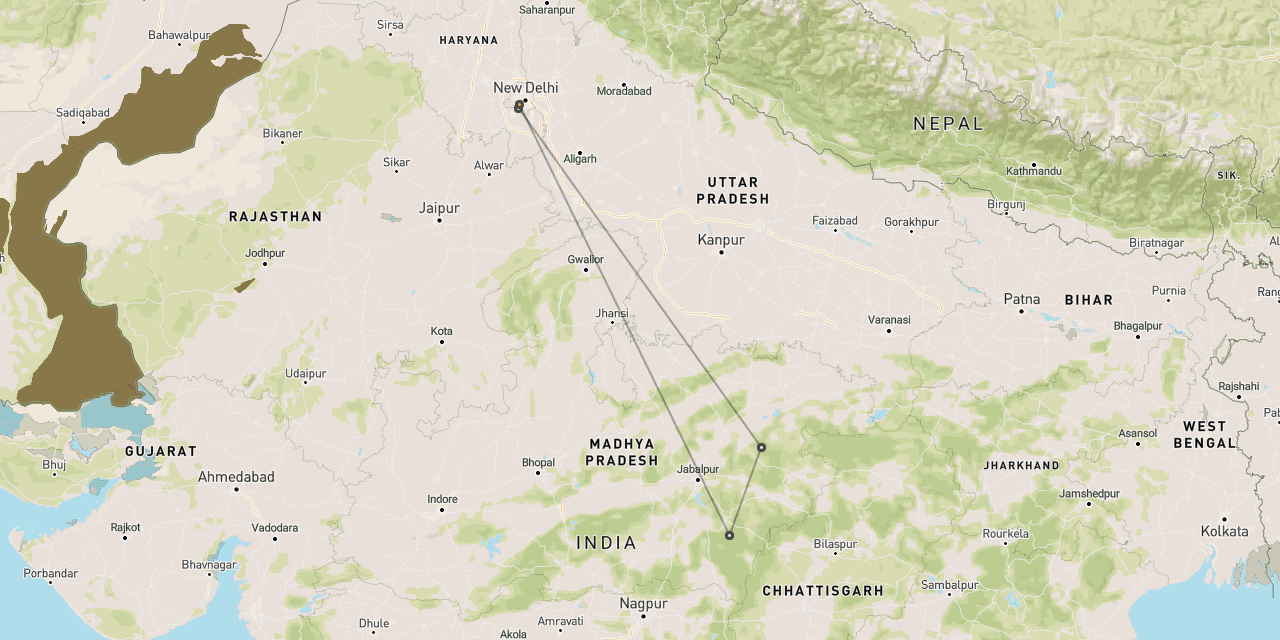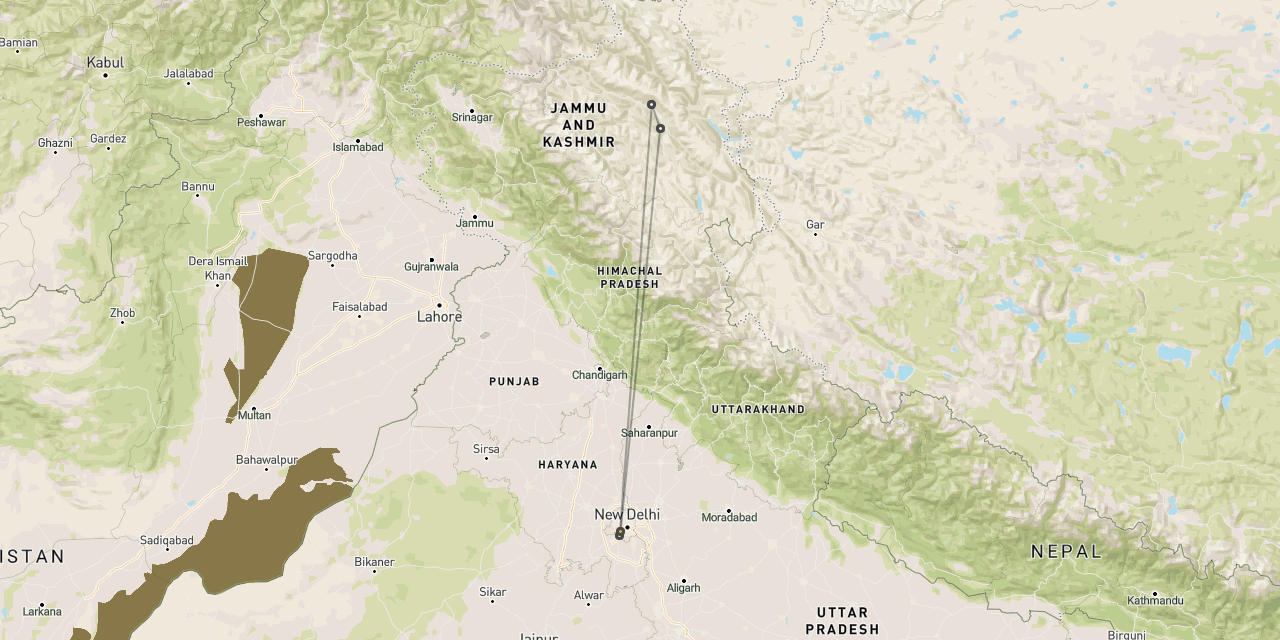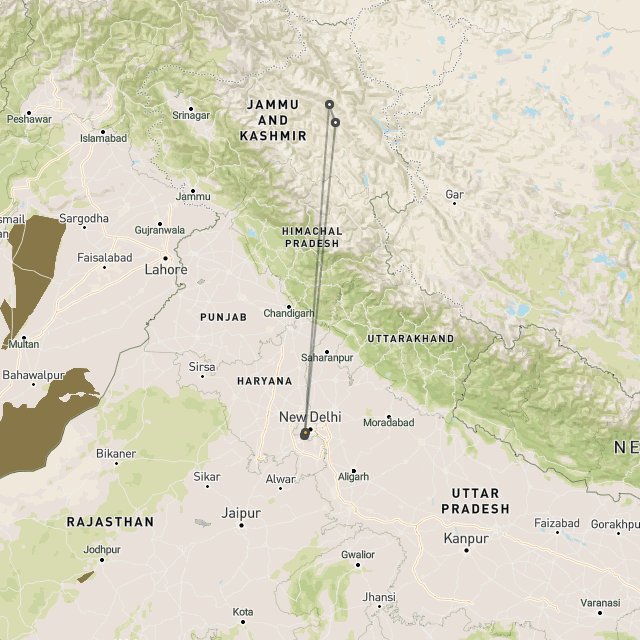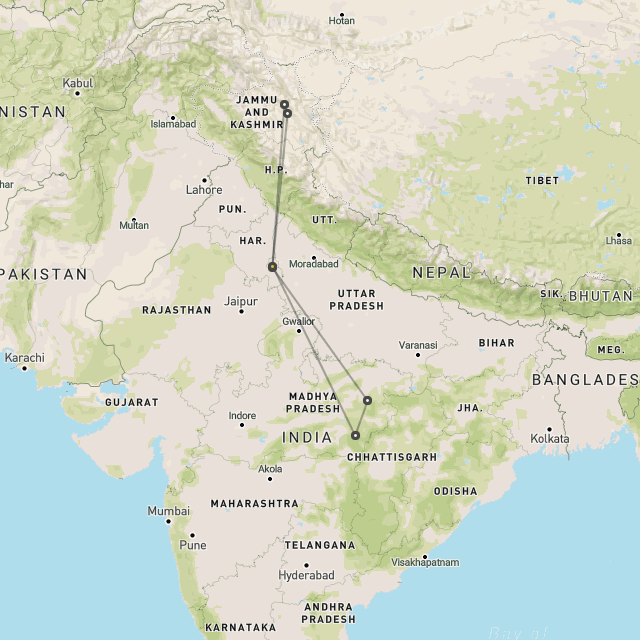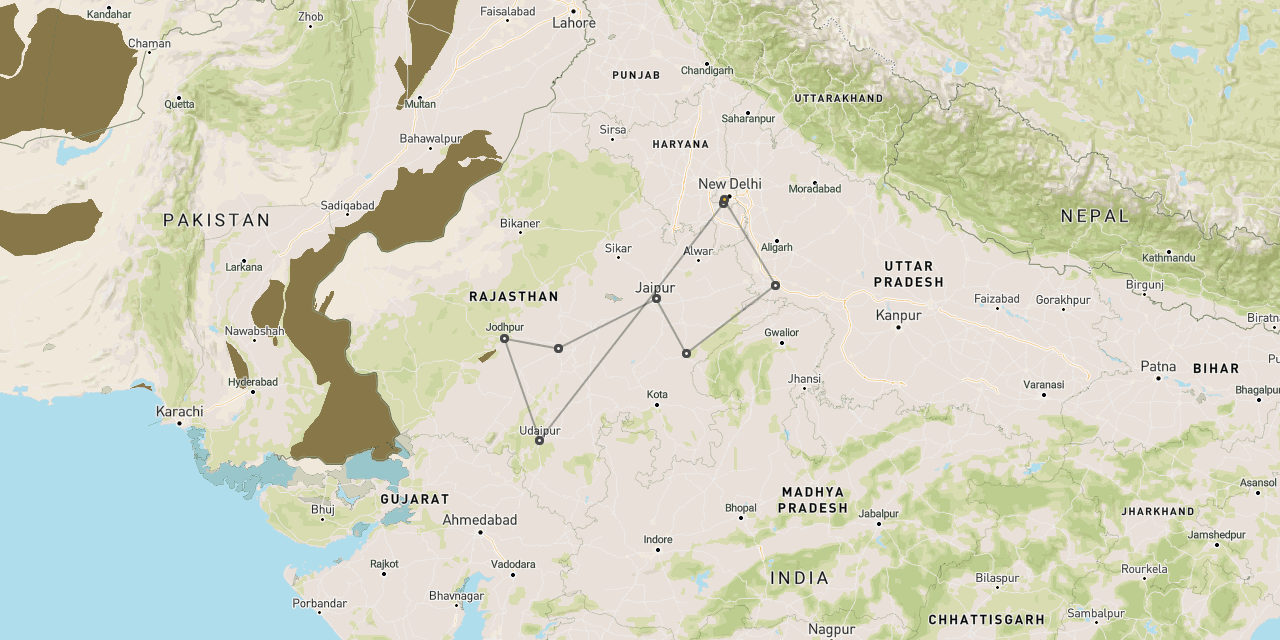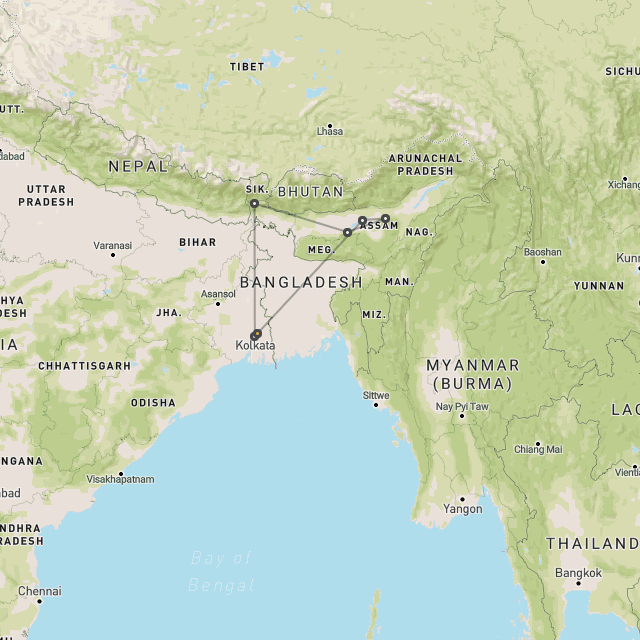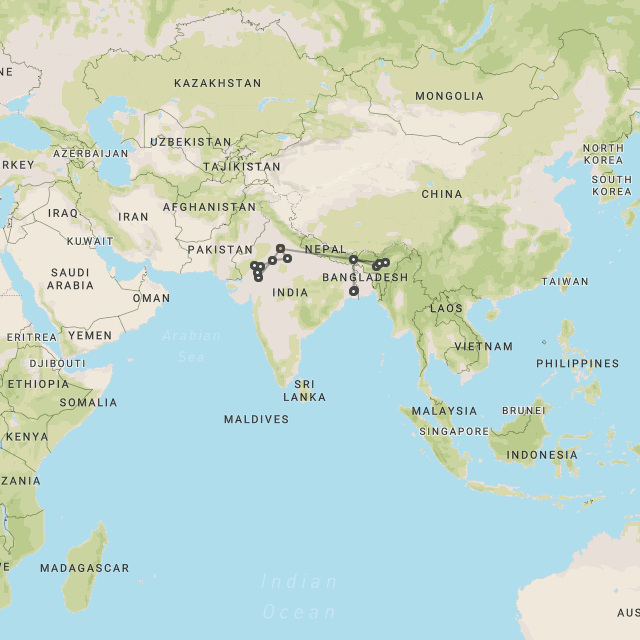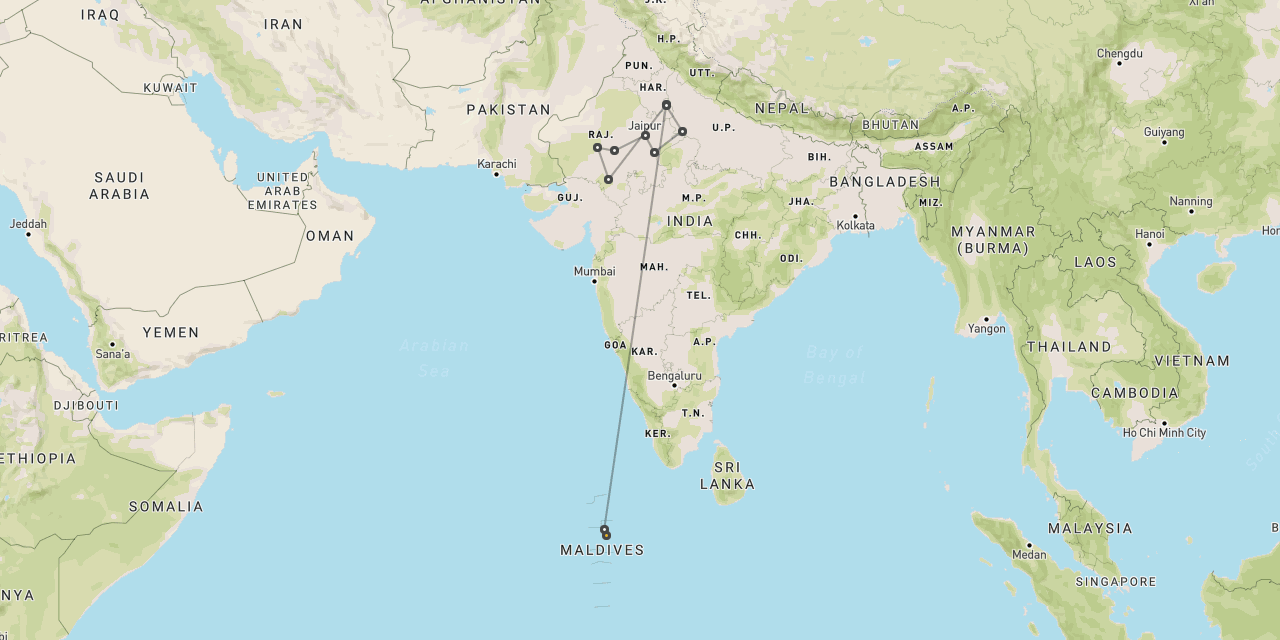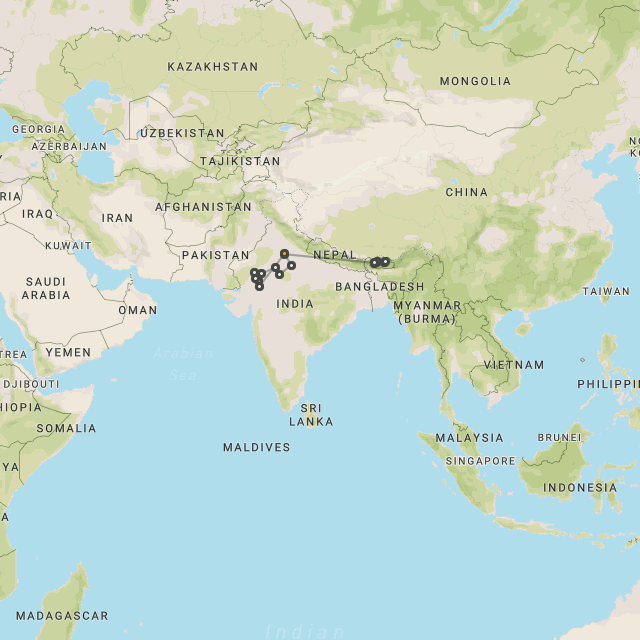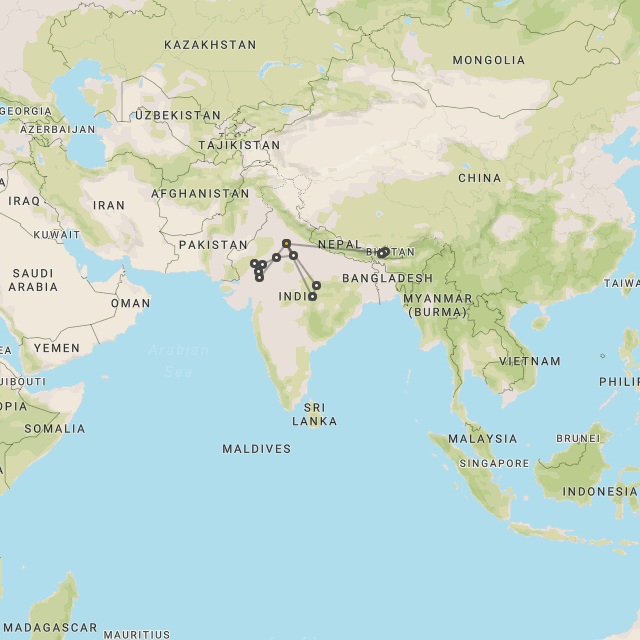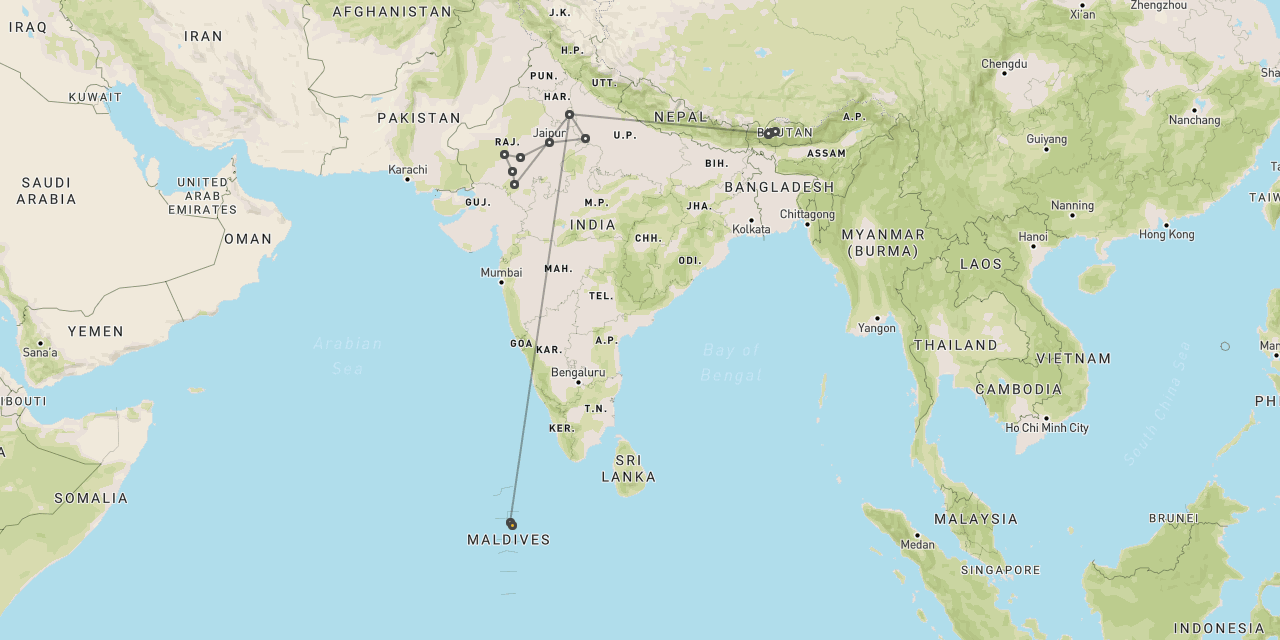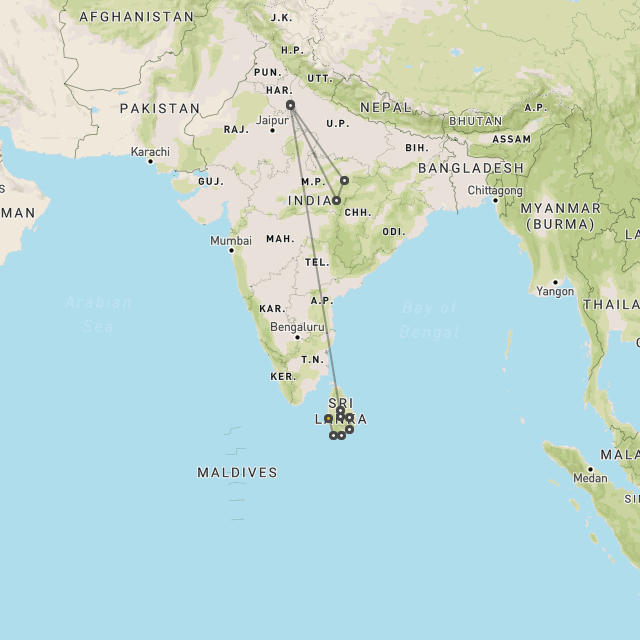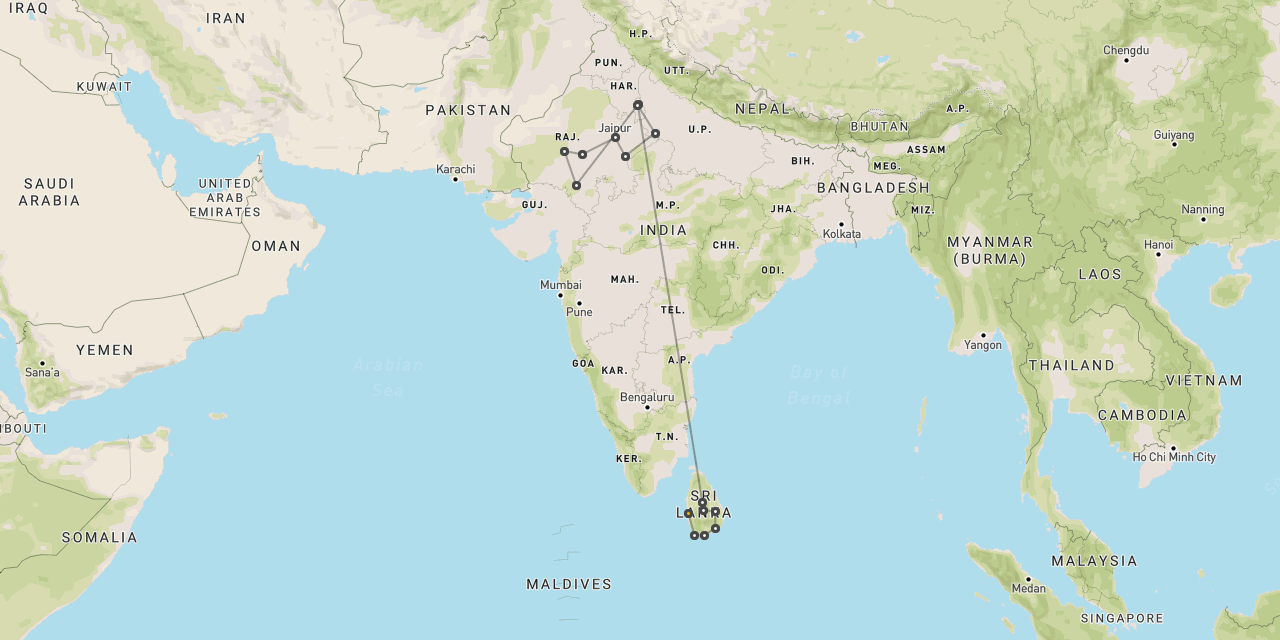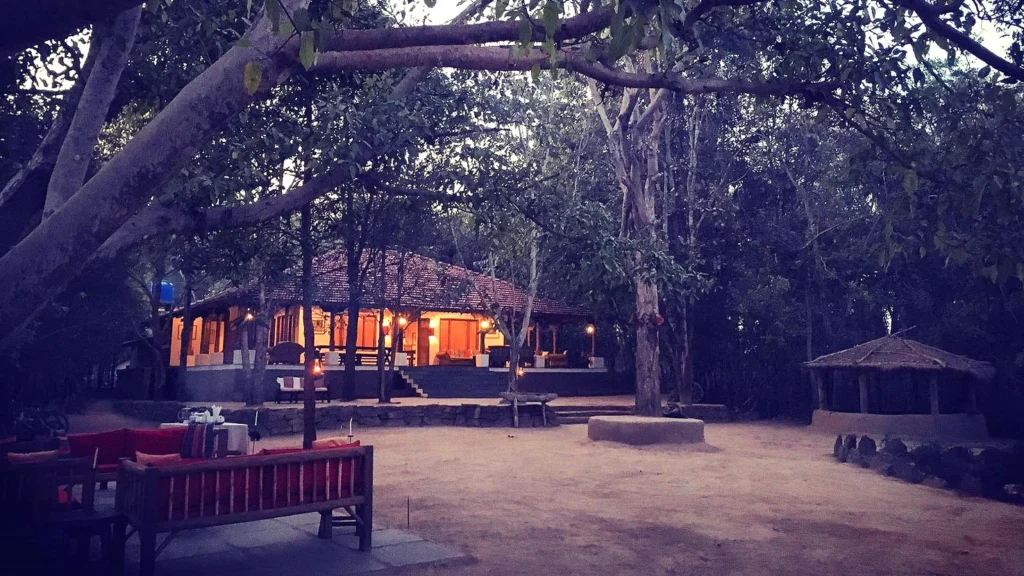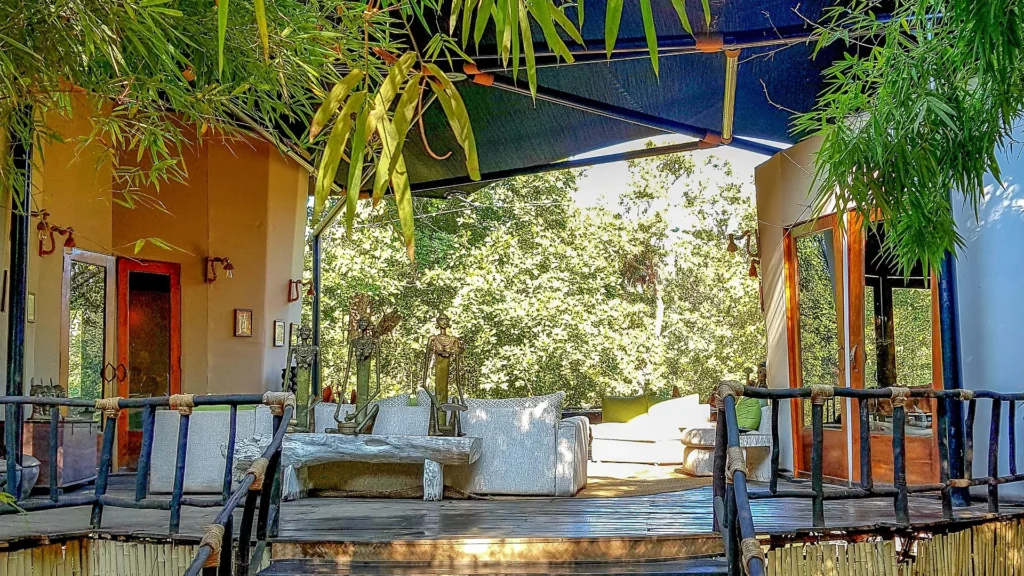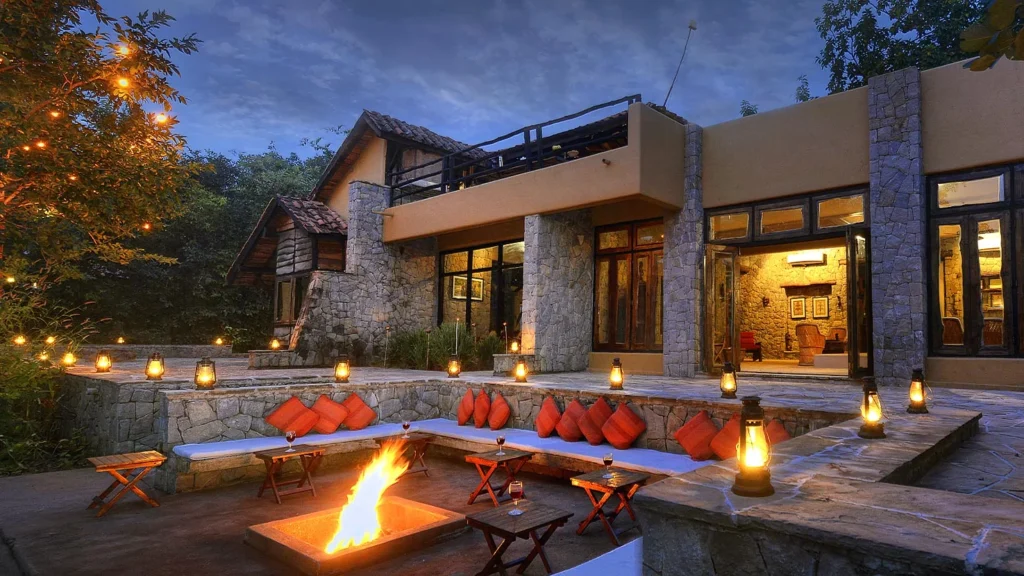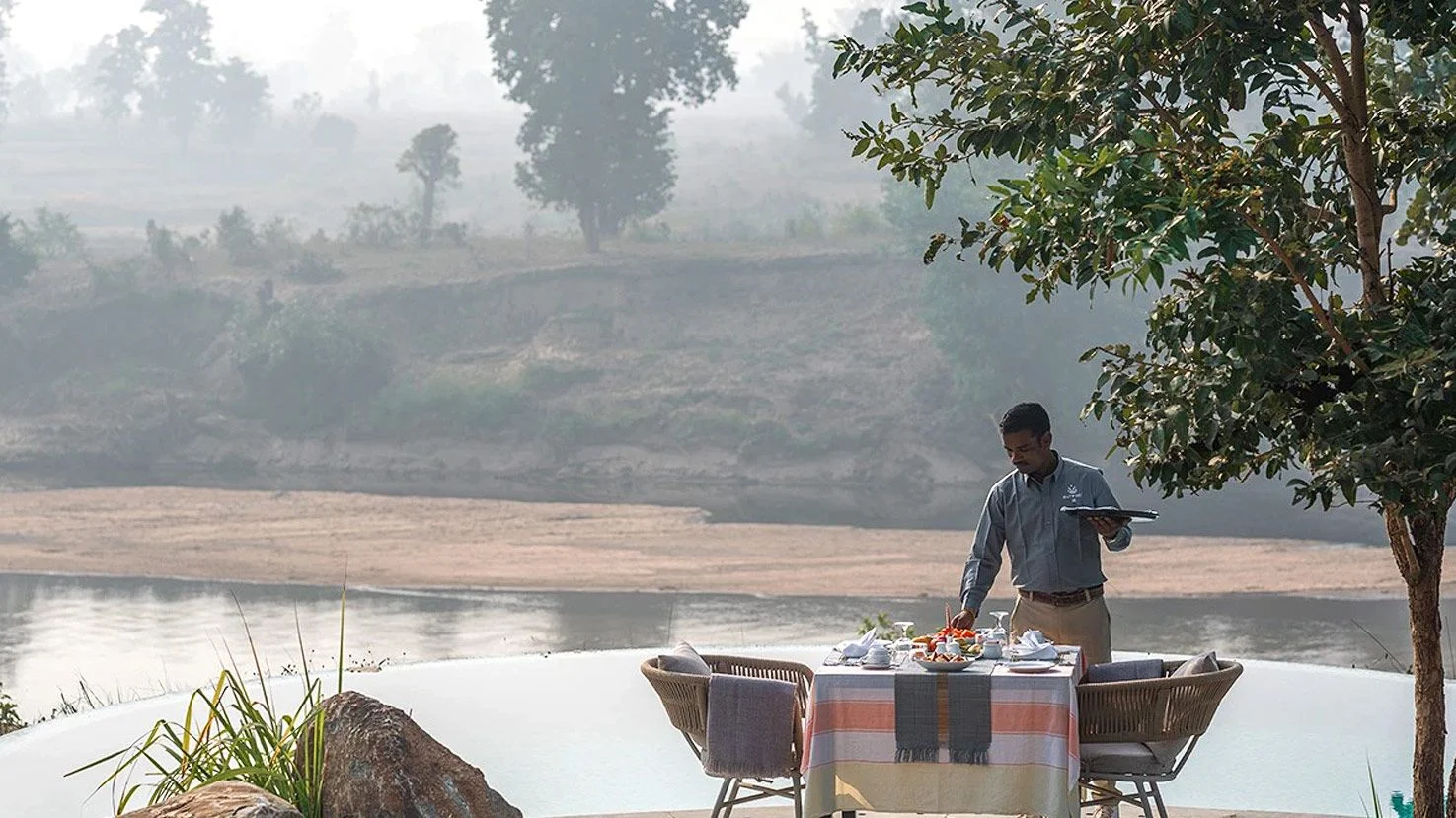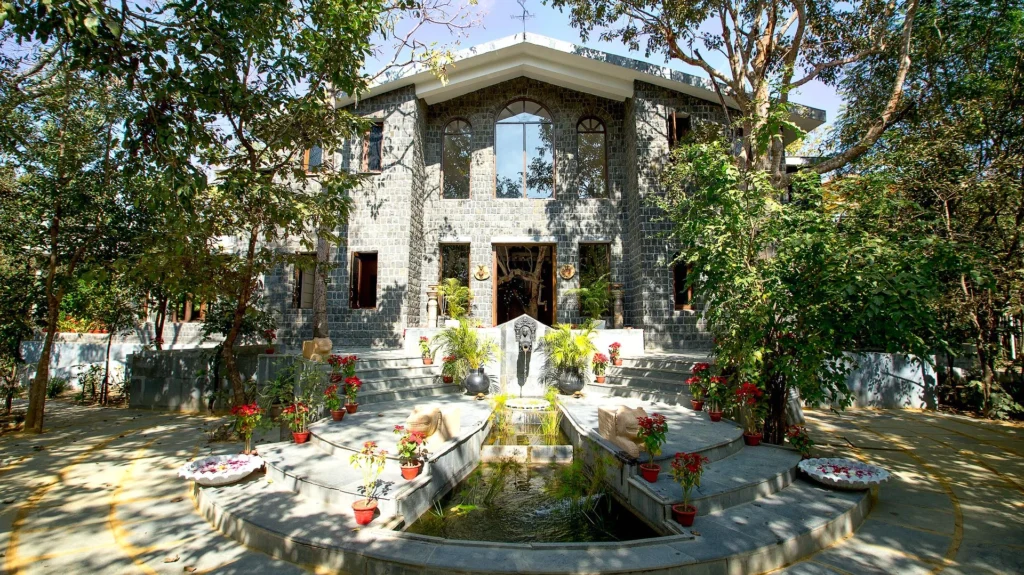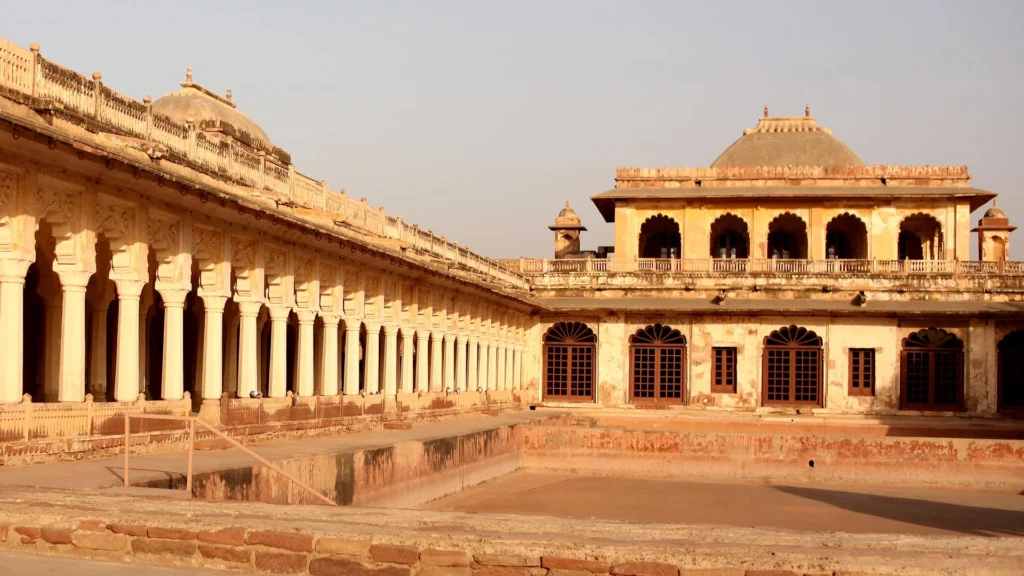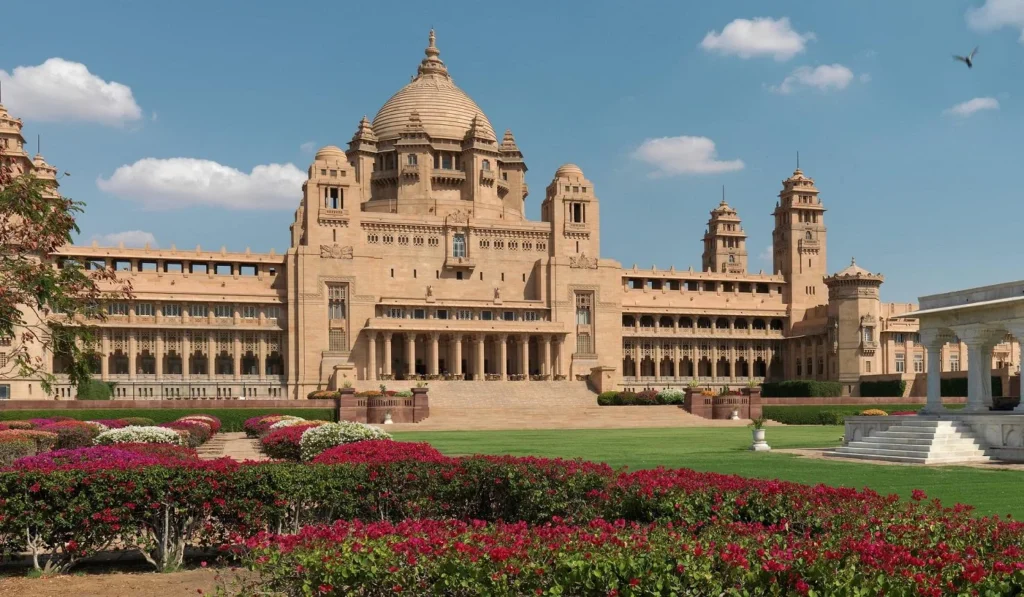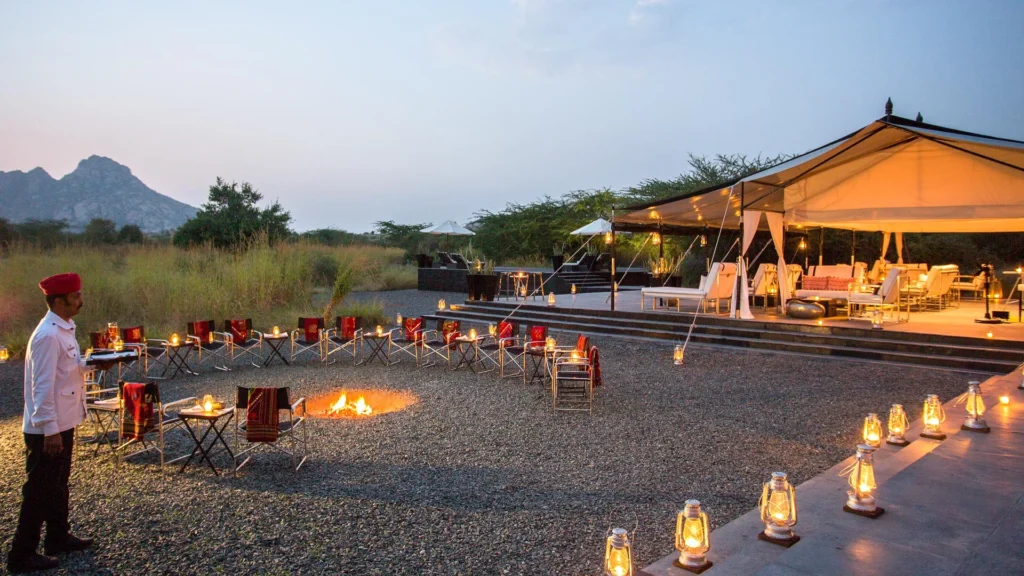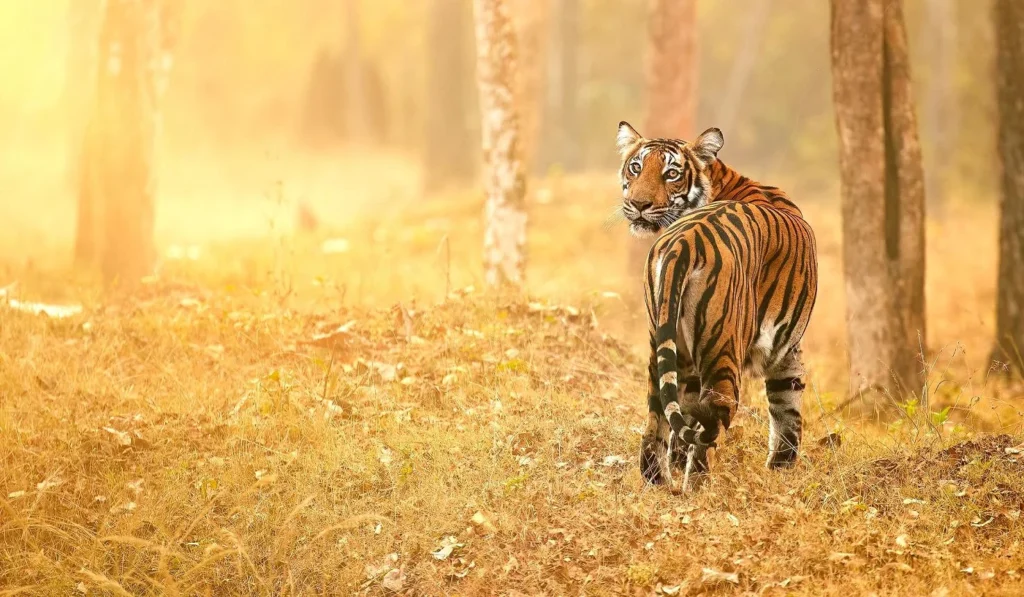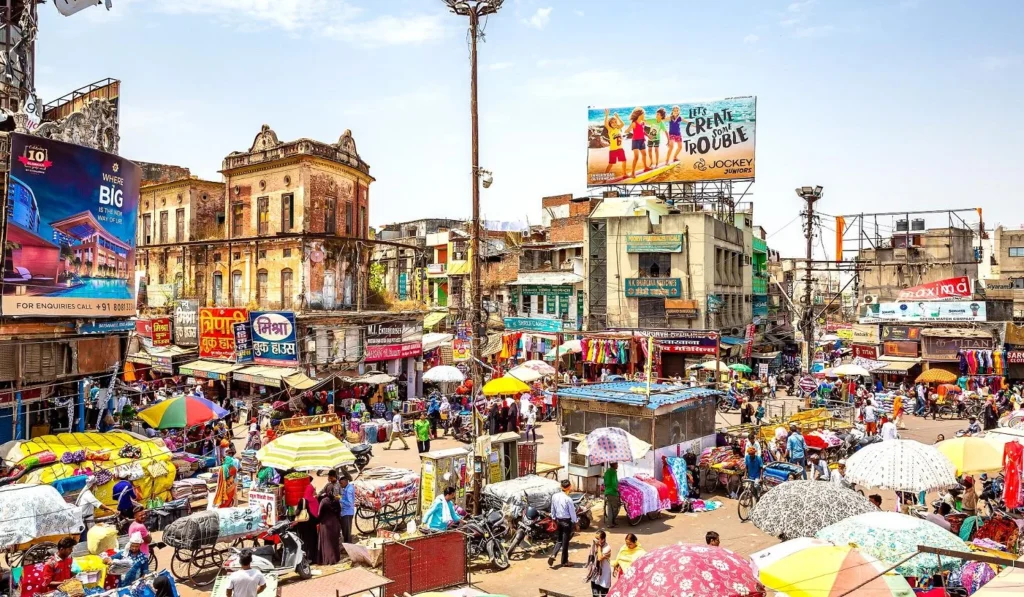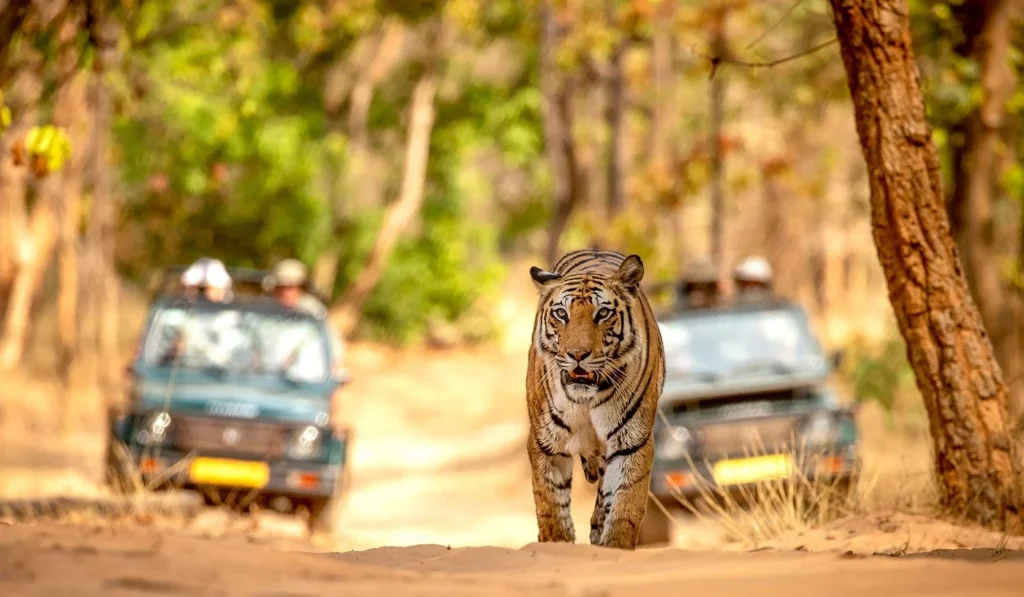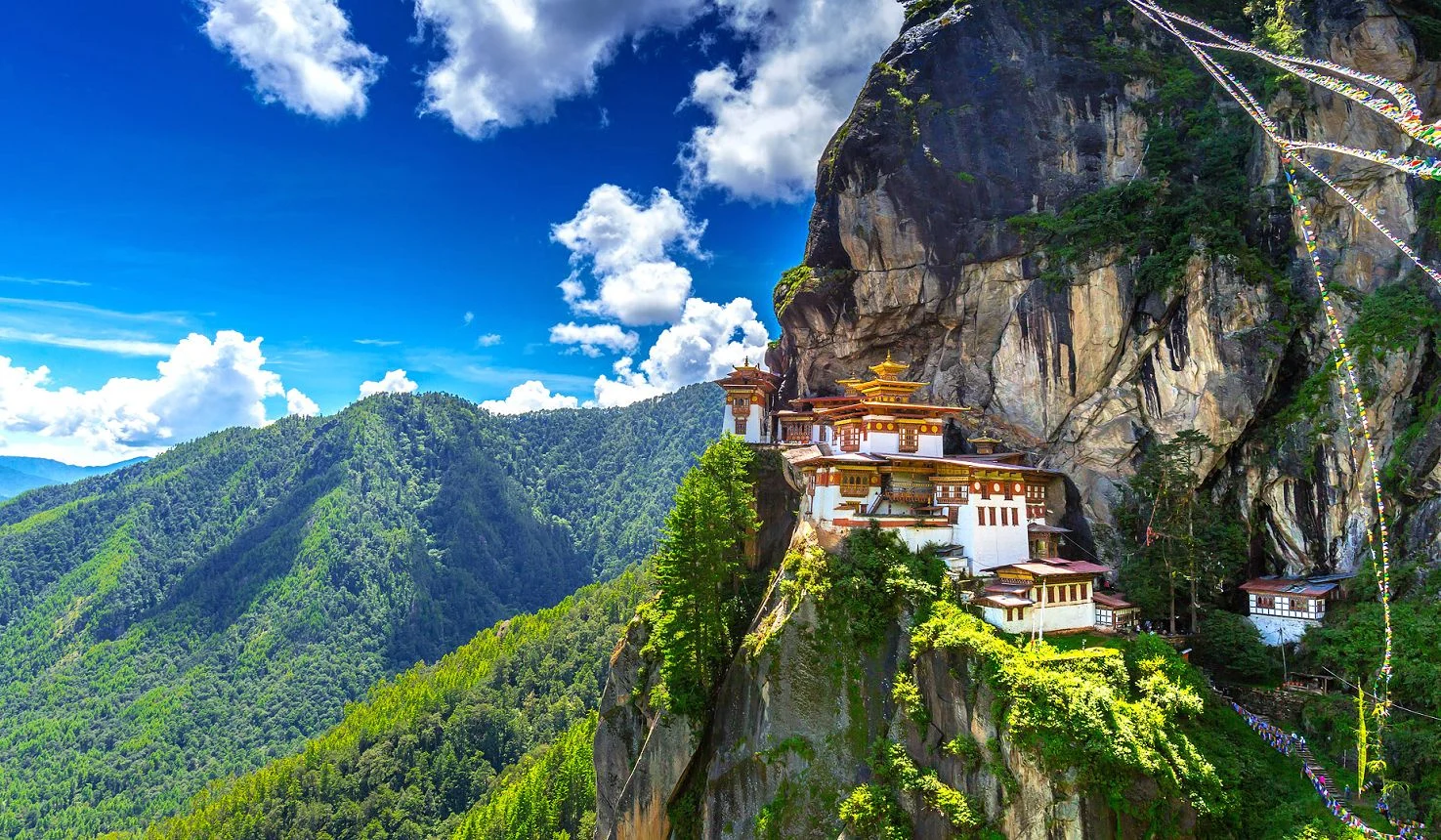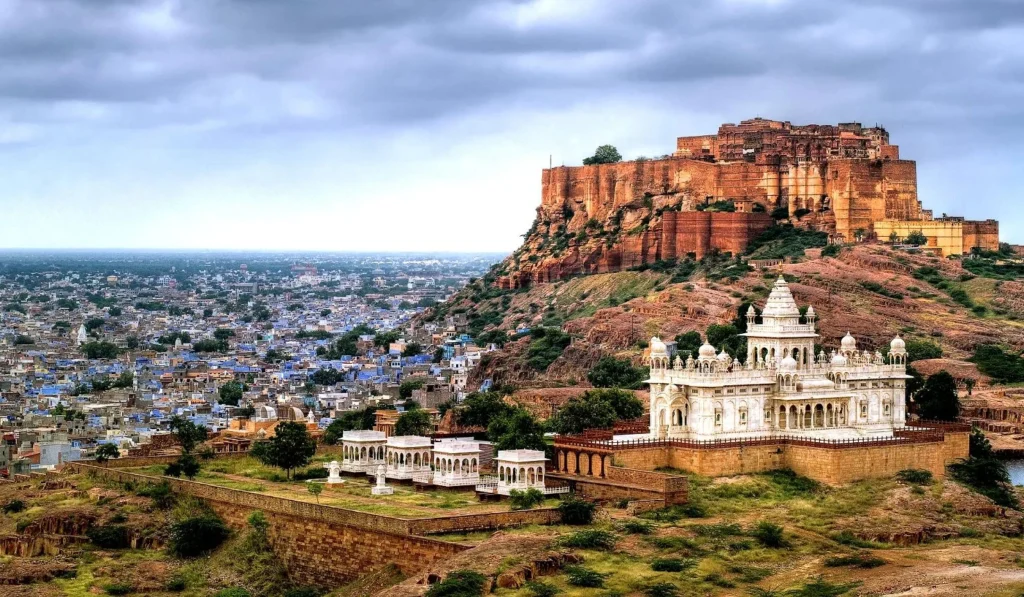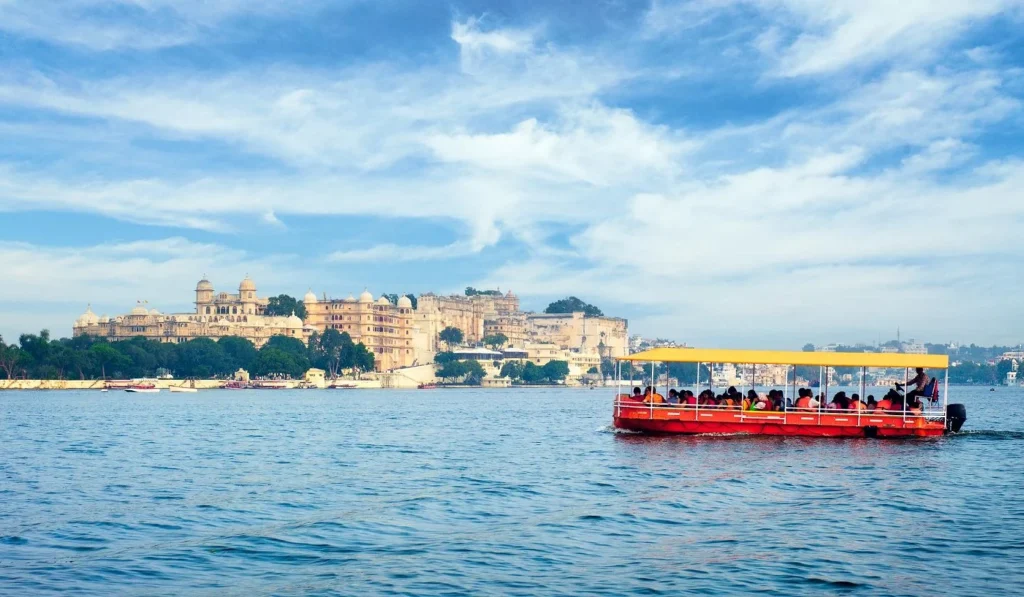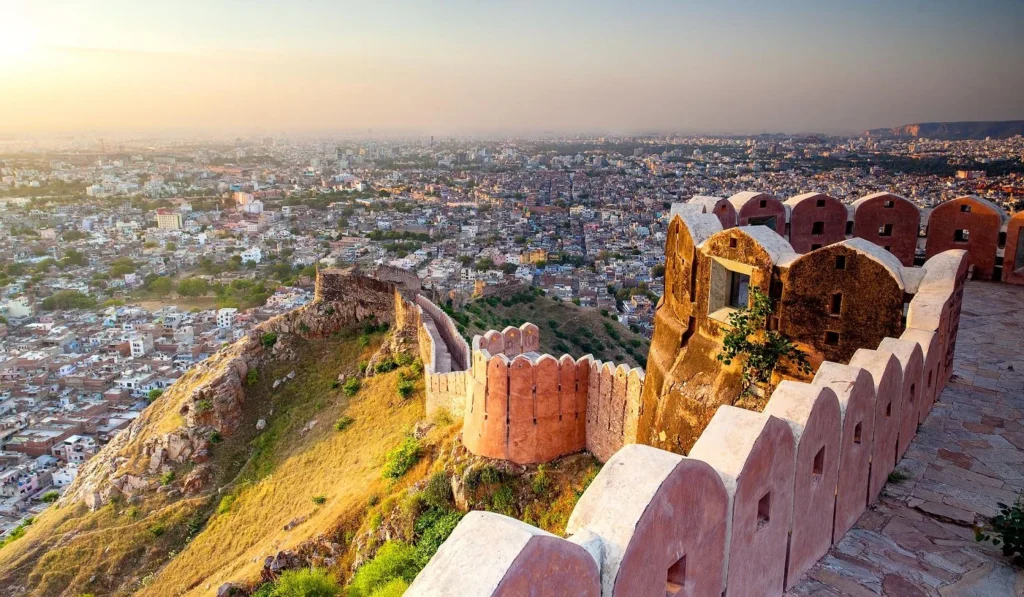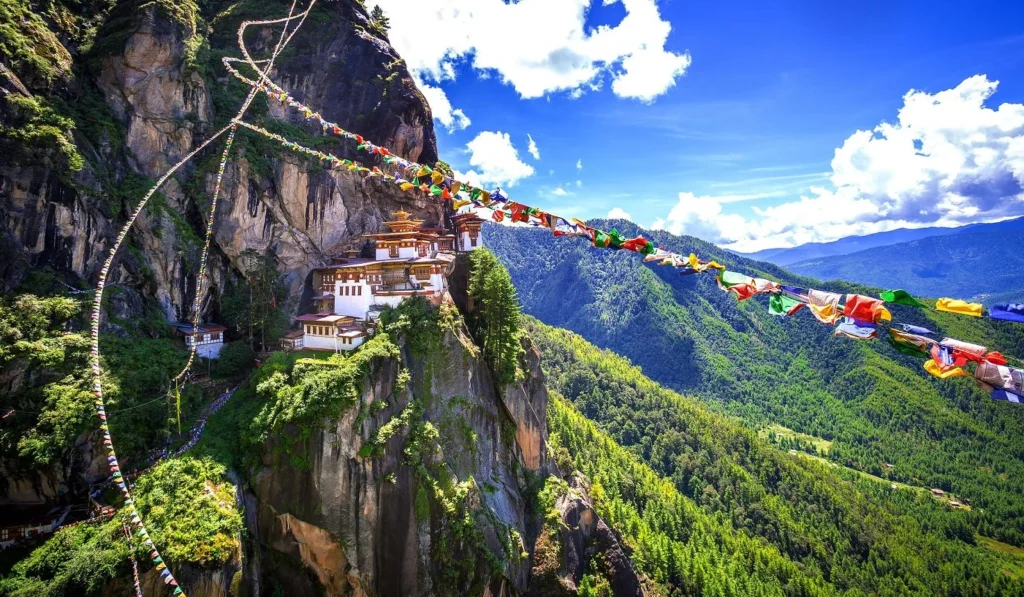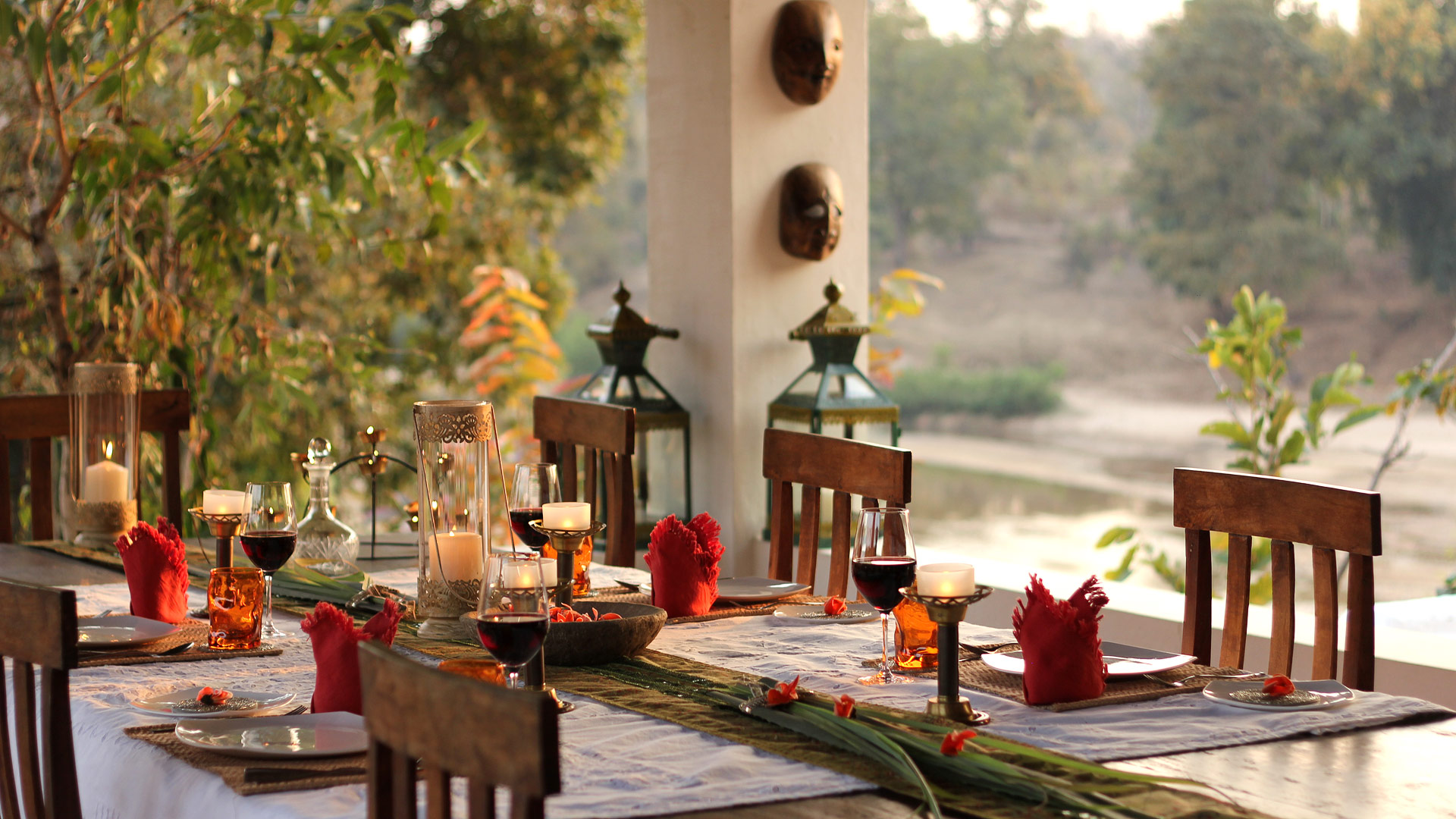
Flame of the Forest Safari Lodge
Flame of the Forest
is an intimate lodge
in the Kanha area
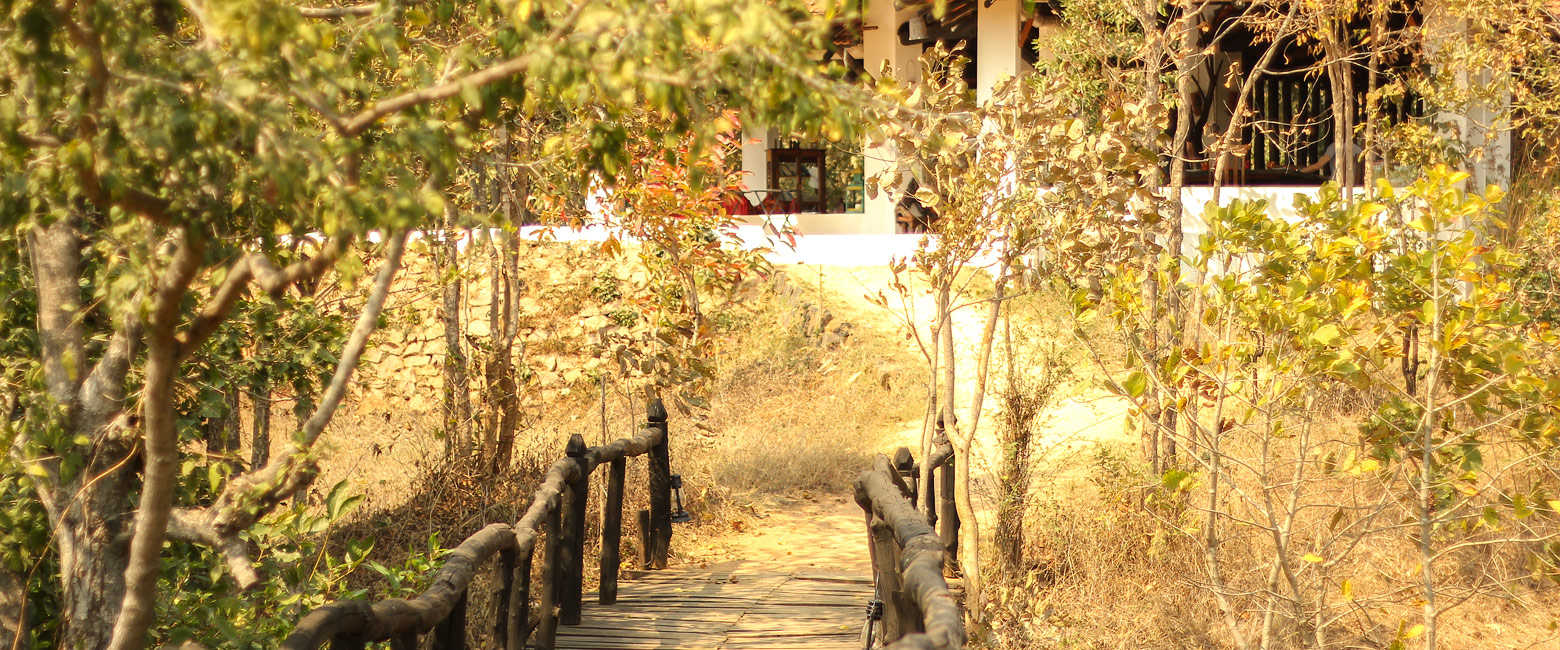
our usual preferred option for this excellent reserve
Set a few kilometres north of the northwestern Kisli Gate into Kanha Tiger Reserve in Madhya Pradesh, Flame of the Forest Safari Lodge is a deliciously intimate, personable and peaceful property.
The lodge is set in a shady forested plot alongside the seasonal Banjar River, surrounded by pleasant farmland and with the forests of the reserve as a backdrop.
The owners offer “a holistic wilderness experience in a natural, healing environment, where like-minded people from all corners of the world share time with an experienced and enthusiastic team”.
The lodge is centred on a simple but very pleasant main building, leading out to a verandah with views out over the river and a genuinely sociable campfire area.
Being open-sided, the main areas do not have conventional air-conditioning. Instead, they roll down reedwork blinds and use a traditional cooling device in which a fan drives air through a bale of moist hay. It’s a little noisy and does create an odour slightly reminiscent of horse stables, but it works well enough.
Rooms
Guest accommodation at Flame of the Forest Safari Lodge is in just four rooms, which take the form of traditional vernacular cottages, with spacious bathrooms, outside showers and private verandahs.
Refreshingly, there are no televisions or minibars. As a concession to modern living, the rooms are now fitted with air-conditioning, which is a boon during the hot season of Apr-May.
Activities
Flame of the Forest Safari Lodge offers a range of guided activities …
- vehicle safari
- village visits
- scenic walks
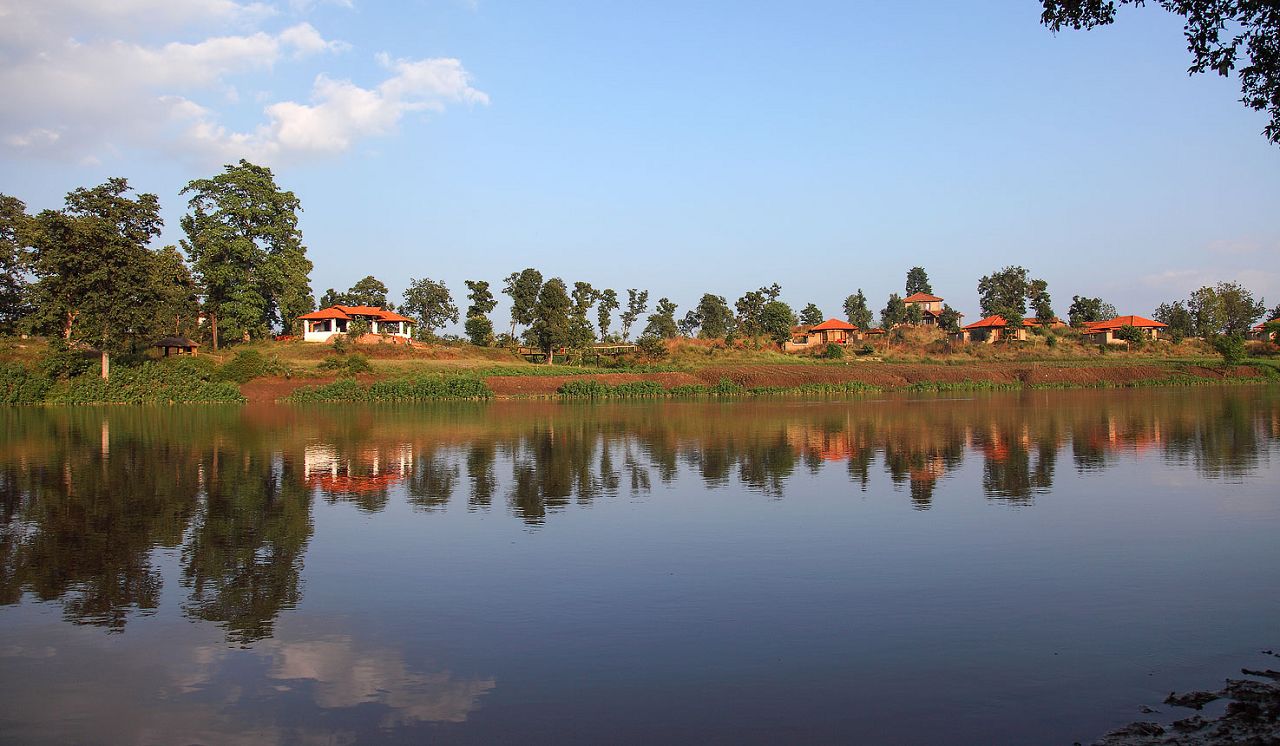
Gallery
Map
Most guests heading to Madhya Pradesh for tiger safari fly from Delhi to a local airport, then combine two or three different reserves by road, typically staying 3-4 nights in each location.
In order of descending popularity, the reserves are Kanha, Bandhavgarh, Pench, Satpura and Panna.
Seasonality
The best time of year to visit the Kanha area is generally considered to be during Oct-Jun, although there are considerable climatic variations over that period.
During October the daytime temperatures usually rise to around 25C/77F, whilst the nighttime low temperatures hold up around 12C/54F. However the rainfall is much lower, dropping to around 50mm (2”) per month. Sunshine is around 8 hours per day (around 75% of daylight hours), meaning that skies are usually clear. At this time of the year the national park is lush and green, with water-filled streams. The green backgrounds provide great contrast for wildlife photography, but the long-grasses can be a major impediment to actually finding the animals.
During Nov-Jan the daytime temperatures usually rise to around 25C/77F, whilst the nighttime low temperatures plunge to around -3C/27F. There should be very little rainfall. Sunshine is around 8 hours per day (around 80% of daylight hours), meaning that skies are usually clear. At this time of the year the national park is still relatively lush and green, with enough humidity in the air for great polarised photography. However, the long-grasses can remain a significant impediment to actually finding the animals. Obviously the morning safaris can be very cold and you should bring suitable clothing.
During Feb-Mar the daytime temperatures can climb steeply to around 34C/93F, whilst the nighttime low temperatures manage to drop to a comfortable 12C/54F. There should be very little rainfall. Sunshine is around 9 hours per day (around 75% of daylight hours), meaning that skies are usually clear. At this time of the year the national park is still surprisingly lush, although the grasses should have died back sufficiently to make wildlife viewing a little easier. However there should still be lots of flowers and fresh leaves around, with beautiful fragrances in the air.
During Apr-Jun the daytime temperatures can climb very steeply to around 42C/108F, whilst the nighttime low temperatures manage to drop to a reasonably comfortable 18C/64F. There should be very little rainfall up to June, when there can be 100mm (4”) over the course of the month. Sunshine is around 9 hours per day (around 70% of daylight hours), meaning that skies are usually clear, but this drops in June to 6 hours per day (45% of daylight hours) as the monsoon clouds gather. At this time of the year the national park is relatively dry, the long grasses should all have died back and the visibility for wildlife viewing should be really good. Additionally the animals tend to cluster around the few remaining water sources. Clearly the temperatures are an issue, as is the increased number of insects, repellent is strongly recommended.
The national park closes, usually mid-June to mid-October, due to the very high monsoon rainfall, which typically leaps to over 500mm (20”) per month. Naturally the lodges all tend to close as well, so visiting during this period is really not an option.
Getting there
The closest airports to Kanha and their most common connections are …
- Jabalpur : 100 km to the north : for Delhi, Agra
- Raipur : 150 km to the southeast : for Delhi, Mumbai, Kolkata, Hyderabad
- Nagpur : 200 km to the southwest : for Delhi, Mumbai, Pune, Kolkata, Bangalore, Doha
usually visited in combination with other nearby reserves
let us know your thoughts about India
and we will help you create the perfect safari
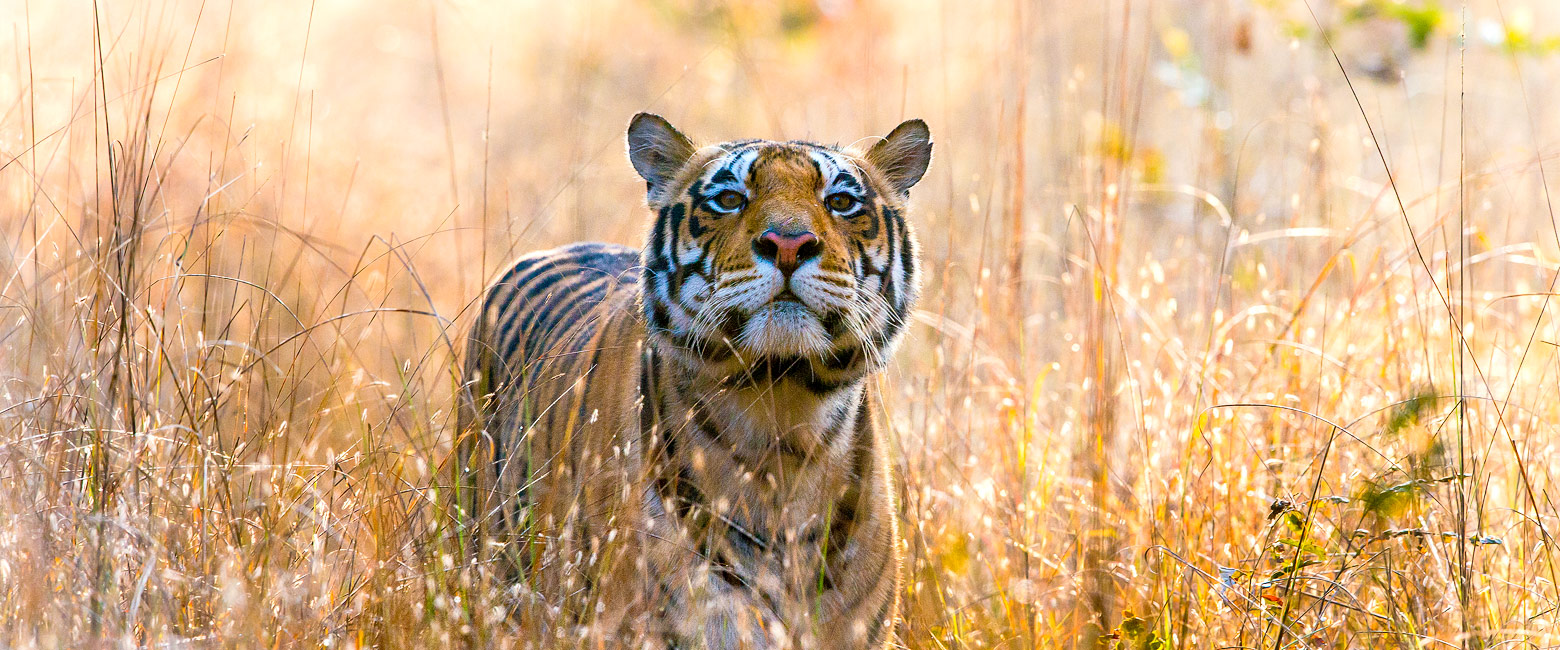
Extraordinary tailor-made adventures,
from earthy and edgy to easy and extravagant
From around USD 2500 per person, you set the ceiling
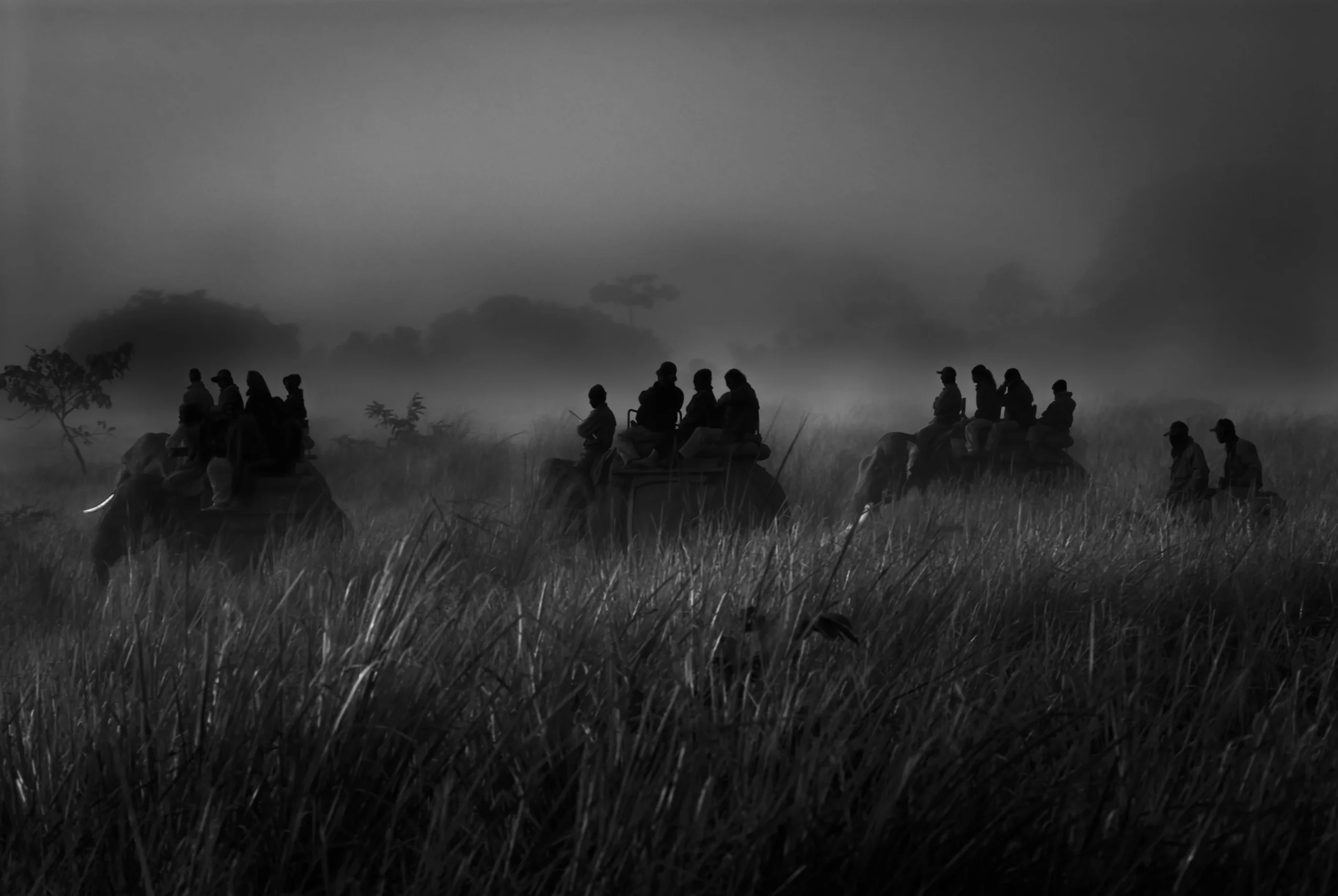
Get started on your trip
It’s never too soon to get in touch, we are here to help with every stage of your planning.
Sample Trips
Here are some of our popular trip shapes
Best Lodges
We regularly inspect and photograph all of the the best lodges, to ensure that we always recommend the most suitable options
Key Locations
Take a look around related locations. Click ‘View more’ to explore locations further afield.























